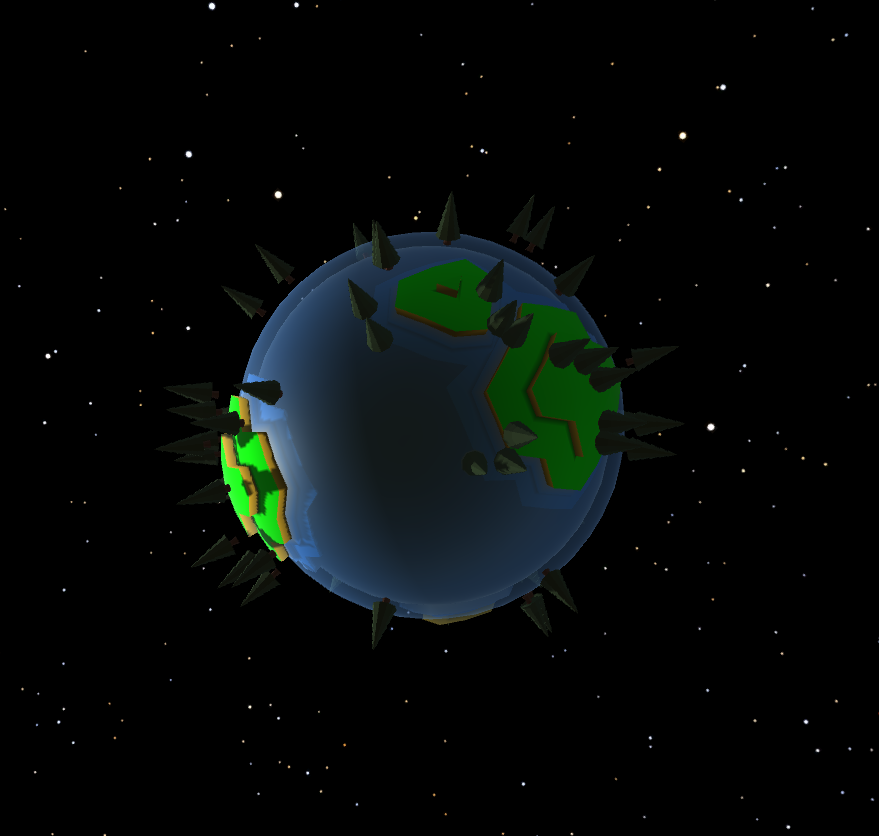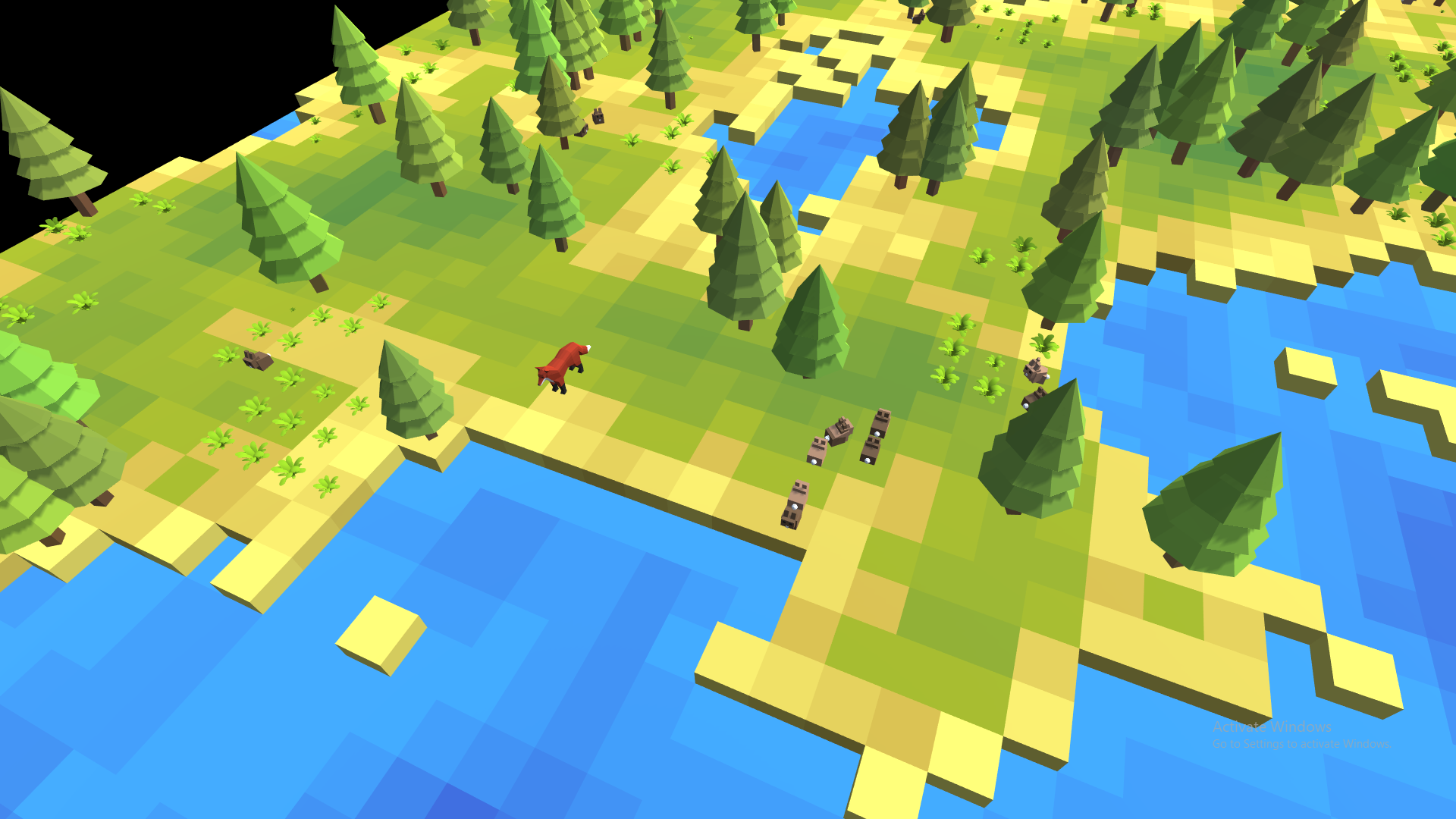Integrating Procedurally Generated Planets and Ecosystems
View Demo
·
Report Bug
·
Request Feature
USRP.Video.mp4
You can find the entirety of the research proposal in the GitHub folder. It outlines my inspiration, process, timeline, and expected outcomes of this project.
During this week, I researched the possible resources that would aid in helping me create procedurally generated planets. I'm currently looking at two game engines: Unity and Unreal Engine 4. The engine which has more resources for this research project will likely be the engine I will use for the remainder of the project.
- Here is a youtube playlist by Sebastian Lague. It outlines some of the core elements I would like in a procedurally generated planet such as biomes and oceans.
- Creation of the planet: 3 methods: a sphere with triangles around the axis, a sphere with triangles the same shape, and an inflated cube.
- Use a script to generate the mesh of a side of the cube or the "terrain face," then use another script to create six of these to create a cube. Then make sure each triangle is equadistant from the center of the sphere.
- Create a scriptable objects to easily modify the size and color of the planets.
- Use open source Simplex Noise to have smooth noise to deform the sphere to look more like a planet.
- Combine multiple noise layers to create a sphere that resembles more of a planet.
- Use a mutitude of noise filters to create varying terrain (i.e. sharp vs round mountains).
- Use a shader graph to give the planet different colors depending on elevation.
- Here is another youtube playlist by Sebastian Lague that walks viewers through procedural land-mass generation. It could be integrated in this project to have more depth to the landscape.
- Here is an article by Peter Winslow which walks an individual through the creation of a low-poly procedural planet.
The article only has a total of three parts; meaning as whole it will be unfinished.
- Winslow discusses two different type of planets, similar to Lague: one with a cube-based sphere and one with a icosahedron-based sphere. He notes the differences are that the cube-based is easier to texture uniformly whereas the icosahedron-based sphere is much harder.
- Extrude certain parts of the planets so that there is a terrain elevation difference.
- Use ambient occlusion to make the ocean clear / ocean depth.
- Here is a reddit post which shows images of a low-poly planet and it cites the resources that were used (many of them were actually unity resources mentioned above).
- Here is the first part of a two part series on creating the basic shape of a planet with a mesh.
- Here is a youtube playlist by Tefel who goes into depth with Unreal to recreate a Minecraft like procedural generation.
Because the present research that has been conducted on procedurally generated planets, especially on the low-poly style that I desire, is mostly found utilizing the Unity engine, I plan to use Unity in the remainder of the project. By making this decision, I am trying to streamline the process. I am trying to make the deadline of the project along with ease the learning curve that comes with game development. I created the Unity project (on version 2019.3.15f) and I chose to the Universal Render Pipeline because I wanted to the project to be viewable by a large audience. I plan on deploying to both web and desktop so by keeping that in mind, I knew the extra features of the High Definition Render Pipeline were unnecessary. I have also watched and outlined the keypoints and concepts from the videos. I will review these during Week 2 when implementing the procedurally generated planets. I hope to combine the work of Lague and Winslow to expand the low-poly planet to have differnt biomes and assign different environmental values to each region.
During Week 2 I began implementing the systems for procedurally generated planets. I mainly followed Peter Winslow's tutorial to achieve the look. I fixed some bugs because the tutorial was a little outdated, also meaning that I could use the desired render pipeline.
- Added trees to the planet.
- Added stars/space themed skybox.
- Adjusted the camera controller to zoom in and out based on fov rather than distance; smooth-damp instead of lerp.
- Fixed a bug that didn't properly render the shaders.
Here is a picture of the progress with procedurally generated planets:
However, there is a limitation to Winslow's method. Further subdivisions of the planet consume large amounts of memory, to the point where 4 subdivisions would prevent the project from being run using WebGL. That means that finer levels of detail would be unachievable because the scale would be too small. I am considering this limitation in the future. At this point I felt like I had a good basis on having a procedurally generated planet, now I started my research early to find a way to incorporate an ecosystem.
- Here is another video by Sebastian Lague that details a environment with three species: foxes, rabbits, and plants.
Lague linked his codebase for the project, but it remains largely unfinished; even less finished than what the video shows. I downloaded it and I have been experimenting with the ecosystem. It uses a procedurally generated tiled map and a coordinate system in order to map the entities. This is slightly off track with the planets; but I might restructure the project so that the focus of it is on the ecosystem; because that is the bulk of it. Were I to try to combine the two; I would have to find a way to map a coordinate system to a sphere and that might prove challenging. I believe that making the ecosystem very depthful and extending the terrain procedural generation may be the best way to take this research project.
Here are the most significant changes I made:
- Made behaviour more "animal-like," animals no longer only ate and drank and did nothing else.
- Added two different cameras to view the simulation.
- Fixed perspective rendering bug with the terrain material.
- Fixed fox eating bug not killing the rabbit.
- Added animal reproduction.
- Added death by old age and exhaustion.
- Varying animal movement speeds.
- Added plant reproduction.
Here is a snapshot of my progress so far:
You can also play the release 0.6 to see it in action.
I found a YouTube channel, Primer, that deals with the concepts behind simulating evolution and many other factors that go in to organism and life. Some of their resources are coded in python, so I may be able to have a better understanding and model similar situation in my research project.
- Primer utilizes numerous math equations to represent different concepts in evolution, and it could prove useful to utilize these equations when modelling my ecosystem.
- In primer's video on exponential growth; primer displayed how there was a similar trend in the current simulation I currently had.
- In the video, "How life grows exponentially," we see that different values for reproduction and death and be modelled to determine whether a species thrives or goes extinct.
- In "Mutations and the First Replicators," Primer discusses the math concepts behind mutations. Although my simulation will not be modelling first replicators; it will share similar details for mutations. The uniqueness in Primer's simulation method is that the mutation occurs by chance and is asexual. My ecosystem will be more focused on sexual reproduction.
- In "Simulating Competition and Logistic Growth" we discuss the math behind carrying capacities. In my ecosystem, I hope to be able to view similar data when running the simulation.
In week 4, I plan on implementing the majority of the genetics. I plan on having genes that control speed, hunger, vision range, etc. I hope to set up an architecture that will allow for new genes to be added seamlessly.
In primer's video, "Simulating Natural Selection," they define a set of rules for the ecosystem; they have genes that control speed, energy efficieny, and sense range. I hope to incorporate the same cahracteristics in the animals in my ecosystem. It's also interesting how Primer graphs their simulation data over time. I hope to do this with assets in Unity. While we are trying to model population evolution in the ecosystem, the genetic makeup is simplified so that it's not necessarily realistic, but it can have insights in to the real world. Primer defines a "gene" as the unit of natural selection. Primer also covers different gene types, such as selfish genes of altruism. I might implement altruism but not inclusive fitness, but rather kin altruism which is more common in nature. Additionally, Primer also discusses "the Evolution of Aggression," which I might implement once both foxes and bunnies have been completed.
- Added gene mutations for speed.

